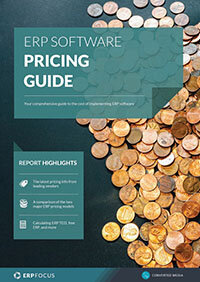How ERP can reduce administration costs
Commercial enterprises exist to make a profit. In an ideal world, all activity would be focused on that objective but the reality is that many activities that they undertake don't directly aid profitability and instead are a cost that has to be borne. Most of these activities, though, are essential: take for instance the payroll function. That generates nothing to increase profitability but without it, there would be no profitability because there would be no employees. All that companies can hope to do is to minimize the cost of these functions; either by doing things more efficiently or by eliminating individual tasks that don't justify their cost. This article looks at using ERP to reduce administration costs in sales, purchasing, manufacturing, and finance.
Sales administration costs
Another article in this series approaches this from a different angle but, here, only cost reduction is considered, and for most companies that means reduced sales order processing transaction costs. An ideal solution is automatic order entry using EDI but this is not always possible so, if manual order entry is required, the challenge is to reduce the amount of time and effort involved to an absolute minimum.
Many companies have many customers who order the same items repeatedly, so the first thing that ERP can do is to enable 'template' orders to be held on the system, with those products pre-loaded so that all the operator has to do is to work down the list, entering or amending order quantities and deleting unwanted items as they go. Another option for some companies is to have a 'search and copy' option; looking at previous orders for a particular customer and searching by product code or customer order number
Lastly, it goes without saying that product price lists and discount tables should be held on the system. Relying on order entry staff to look them up manually adds time and the risk of error to the process.
Purchasing administration costs
Companies have been using Materials Requirements Planning (MRP) systems for years to recommend purchases and to have the system automatically raise orders for approved recommendations. Usually, the recommendations default to 'approved' status so that only exceptions require purchasing staff to manually intervene in the process.
But then some of them print off the orders and send each one for managerial review and authorization, just as would have been done a hundred years ago. When asked why they do so, the replies are usually that they need to check that the items are being procured from an approved supplier, that they want to ensure that they are being purchased against a valid requirement, or that they need to check that the prices are correct. These are all things that a properly implemented ERP system can ensure automatically (and if companies have an ERP system that hasn't been implemented properly, then they have more problems than just checking purchase orders can solve).
On a more positive note, by analyzing delivery performance and reject history, an ERP system can be used to identify good suppliers and problematic suppliers. In the short term, that means that failing suppliers can be brought in for discussions about the problems being encountered and about how those problems might be addressed. In the longer term, if problems persist, these companies can be taken off the approved suppliers list and their orders transferred to their more reliable competitors. A useful side effect of this is that the overall number of suppliers will decrease, allowing more time to be spent building relationships with those that remain (and don't forget that Pareto's Rule tells us that 80% of problems come from 20% of suppliers). Also, because trade with the good suppliers will increase, the company will become more important to them and that should lead to better prices and discounts, and to favorable treatment when goods or services are in short supply.
Lastly, although frequently the Cinderella department, the warehouse can benefit from ERP also. Firstly, it is easy to give them a list of expected deliveries by day so that their workload can be assessed and suitable resources put in place to ensure that there are no delays in processing urgent deliveries. Additionally, a good warehouse management system can greatly reduce workload (and required staffing levels) by generating intelligent put-away instructions; ensuring, for example, that frequently used items are stored as close to the pick face as possible (this is true both for materials that will be picked for production and for product that will be picked for dispatch to customers).
Manufacturing administration costs
These costs can also be reduced by using MRP because, not only can works orders be raised automatically, but the number of such orders can be reduced by consolidating requirements according to user-set rules, and fewer orders to process means less time spent on processing them (see also the article in this series on reducing manufacturing costs). For many companies, processing works orders also includes tracking work in progress (WIP); recording progress and resource machine or labor time for each job and each operation.
Getting accurate information on progress and on resource usage is important because most companies need to know where jobs are, and how much they cost. But some activities take such a small amount of time that knowing if they are complete or not may not be important, so some ERP systems allow progress to be tracked and recorded at key milestones only. When a job reaches a milestone, all preceding tasks are assumed to have been completed (as indeed they must have been) and to have been completed in standard time.
Taking this one step further, it is possible for some companies to assume that, when a job is finished, all necessary resources (both time and material) have been used, and have been used in the quantities specified in the item's bill of material and routing, so both operation times and materials can be automatically 'back-flushed' (i.e. the actual operation times are assumed to be what they should have been and the materials used are retrospectively down-dated from stock). Indeed, when items are in regular production, some systems allow works orders to be done away with completely and the only transactions required are back-flush completions, which can be done either at job completion or shift completion depending on overall job length.
Find out the cost of implementing the top ERP systems with our free guide
Finance administration costs
When computers first began to be used for commercial purposes, for most organizations the finance department was the obvious place to start. Accounts Receivable and Accounts Payable are, in particular, transaction-heavy activities and in consequence, finance is very often the biggest overhead (in the sense that it does not generate profit) department in a company. But after over 50 years of using computers to improve efficiency, there is not a lot more left to squeeze out, so companies are increasingly looking to remove activities from processes rather than just do them more efficiently.
One example of this is credit checking at the point of customer order receipt. When companies relied on manual systems, it was normal for a copy of the sales order to be sent to the credit control department, where a clerk would check it against the customer's credit limit; also considering their outstanding balance and existing on-hand orders. They would also check to ensure that there were no outstanding invoices that remained unpaid beyond their due date and, if all was OK, the order would be released.
All of the above can now be achieved automatically by an ERP system during order entry; meaning that human intervention is only required when a problem is found. It is hard to understand why some companies retain manual systems in this area; especially when the staff operating such systems will usually interrogate the ERP system for the data they need.
Moving to the Accounts Receivable function; ERP can automatically raise sales invoices for items dispatched and all that companies need to decide is, first, how frequently they want to do that and, secondly, how the invoices are to be transmitted to the customer. Some customers may want consolidated invoices, covering all deliveries during a week or month, whilst others will demand a separate invoice for each individual delivery. ERP systems can satisfy both of those requirements; although changing to consolidated invoicing can cause cash flow problems if payment terms are based on the invoice date and, for example, an order delivered on the 1st of the month is not invoiced until the 31st.
For most companies, invoice processing in the Accounts Payable section is equally transaction-heavy, so it has always been an area where integrated systems can generate real savings. Before such systems were available, a typical procedure would have been as follows:
1. A hard copy of the purchase order is filed,
2. When goods are received, the Goods In team hand write a goods received note (GRN), which is files with the PO copy.
3. When the supplier invoice is received, a clerk retrieves the PO and GRN, checks that the delivery and invoice quantities match, and that that the PO and invoice prices match.
4. Finally, the clerk sends the collated documents to the relevant manager for review and payment authorization.
Surprisingly, in the 21st Century, there are still companies that work this way, although some have progressed to allowing Goods In staff to print a copy of the receipt transaction rather than hand write one.
But all that is done manually in this procedure can be done faster, cheaper and with less risk of error by an ERP system. Beginning at the point of receipt, the system can check that the delivery quantity matches the order quantity. When the supplier invoice is received and entered, the system can check that the invoice quantity matches the GRN quantity and that the invoice price matches that on the PO. If there is a problem, the system can automatically put the invoice on hold for manual investigation. (Most ERP systems can optionally be given acceptable tolerances on all of these checks so that a difference or discrepancy of a few cents does not trigger a manual intervention procedure.)
This article has discussed a number of things that ERP systems can be expected to contribute to administration cost reduction. It doesn't claim to be a definitive list because individual systems may have unique additional functionality but it, along with the other articles in this cost reduction series, gives a starting point to reducing costs by using ERP systems efficiently and effectively.
Free white paper

ERP Software Pricing Guide
Get the latest pricing information on over 80 popular ERP systems, and learn how to budget for your ERP project in our free guide

Featured white papers
-

Calculating ERP ROI: 5 steps to success
Calculate your new ERP's financial benefits with this comprehensive guide
Download
Related articles
-

Top 10 ERP selection criteria (including checklist)
The most important ERP selection criteria you should keep in mind during your selection process.
-

CMMC Compliance: What Aerospace and Defense Manufacturers Need to Know
Key insights on CMMC compliance, deadlines, and securing DoD contracts with CMMC 2.0 certificatio...
-

How much does ERP cost? (Free ERP cost and budget guide)
How much does an ERP system cost in 2025? Everything you need to make an ERP software budget

